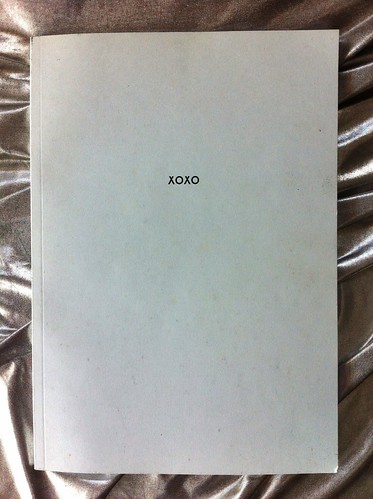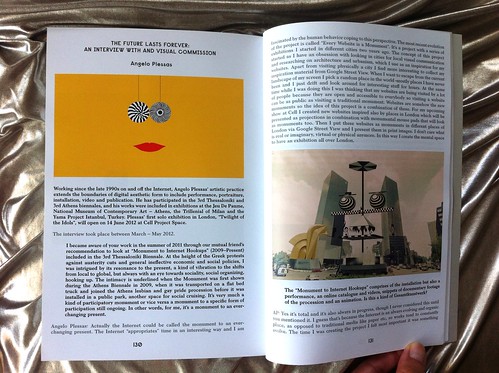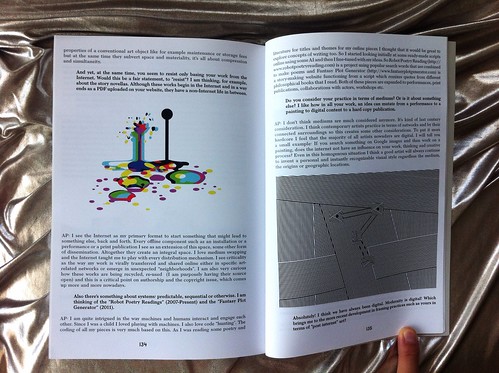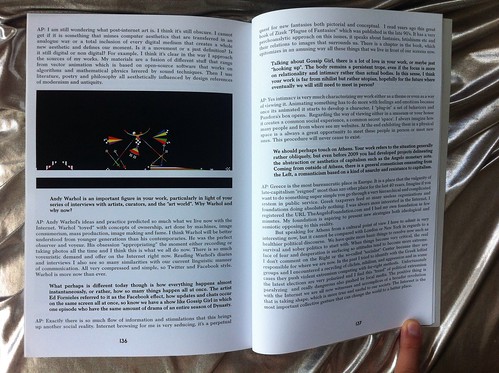The future lasts forever,
interview to Stephan Tanbin Sastrawidjaja for XOXO,
interview to Stephan Tanbin Sastrawidjaja for XOXO,
a publication for the conclusion of the Goldsmiths MFA Curating.
(Read below full text)
The Future Lasts Forever:
An Interview with and Visual Commission by Angelo Plessas
Working since the late 1990s on and off the Internet, Angelo Plessas’ artistic practice extends the boundaries of digital aesthetic form to include performance, portraiture, installation, video and publication. He has participated in the 3rd Thessaloniki and 3rd Athens biennales, and his works were included in exhibitions at the Jeu De Paume, National Museum of Contemporary Art – Athens, the Triennale of Milan and the Yama Project Istanbul, Turkey. Plessas’ first solo exhibition in London, “Twilight of the Idols”, will open on 14 June 2012 at Cell Project Space. The interview took place between March – May 2012.
I became aware of your work in the summer of 2011 through our mutual friend’s recommendation to look at “Monument to Internet Hookups” (2009 -Present) included in the 3rd Thessaloniki Biennale. At the height of the Greek protests against austerity cuts and general ineffective economic and social policies, I was intrigued by its resonance to the present, a kind of vibration to the shifts from local to global, but always with an eye towards sociality, social organizing, hooking up. The intimacy is underlined when the Monument was first shown during the Athens Biennale in 2009, when it was transported on a flat bed truck and joined the Athens lesbian and gay pride procession before it was installed in a public park, another space for social cruising. It’s very much a kind of participatory monument or vice versa a monument to a specific form of participation still ongoing. In other words, for me, it’s a monument to an ever-changing present.
Angelo Plessas: Actually the Internet could be called the monument to an everchanging present. The Internet “appropriates” time in an interesting way and I am fascinated by the human behavior coping to this perspective. The most recent evolution of the project is called “Every Website is a Monument”. It’s a project with a series of exhibitions I started in different cities two years ago. The concept of this project started as I have an obsession with looking in cities for local visual communication and researching on architecture and urbanism, which I use as an inspiration for my websites. Apart from visiting physically a city I find more interesting to collect my inspiration material from Google Street View. When I want to escape from the current landscape of my screen I pick a random place in the world -mostly places I have never been and I just drift and look around for interesting stuff for hours. At the same time while I was doing this I was thinking that my websites are being visited by a lot of people because they are open and accessible to everybody so visiting a website can be as public as visiting a traditional monument. Websites are somehow the new monuments so the idea of this project is a combination of these. For my upcoming show at Cell I created new websites inspired also by places in London which will be presented as projections in combination with monumental mouse pads that will look as monuments too. Then I put these websites as monuments in different places of London via Google Street View and I present them in print images. I don’t care what is real or imaginary, virtual or physical anymore. In this way I create the mental space to have an exhibition all over London.
The “Monument to Internet Hookups” comprises of the installation but also a performance, an online catalogue and videos, snippets of documentary footage of the procession and an animation. Is this a kind of Gesamtkunstwerk?
AP: Yes it’s total and it’s also always in progress, though I never considered this until you mentioned it. I guess that’s because the Internet is an always evolving and organic place, as opposed to traditional media like paper etc, so works tend to constantly evolve. The time I was creating the project I felt most important it was something to be promoted, conceiving every DIY viral method and I felt people just need to look into this kind of communication and don’t be ironic as many people are for this kind of hooking up. l felt a very strong ideology towards it, as it is a personal experience because I started dating online. Apart from this, for me networking and communication is part of this project and my work in general. So this is somehow my version of a perfect “propaganda” for an idea.
Formally, the Thessaloniki Biennale iteration, with the black and white diagonal lines and the amphitheatre very much reminded me of Sol Lewitt and Daniel Buren, an apt description, as both are known early in their careers for their participation in collectives, but also classical architecture.
AP: Primarily I made the thick stripes and this clear geometric forms so could attract attention of people either by walking nearby or could be seen from a plane or even as a distinct object from Google Maps. The stripe thing I use from time to time and it came from an online piece I did called “MeLookingAtYou.com” I barely knew about Buren at that time. This era of these artists is very inspiring, it was an era of utopic futurism and radicallity and these artists were curious to merge science with conceptual experiments, they used public space in a more unexpected way as if they were alchemists. Actually one of the most inspiring texts which I always quote for the Monument to Internet Hookups comes from the essay “Entropy and the new Monuments” by Robert Smithson and it says: “..If time is a place, then innumerable places are possible.” This statement is so appropriate for this project and it’s somehow my interpretation crashing Internet reality and “terrestrial” one.
You identify yourself as a portraitist. I see this very much in the “International Portrait Gallery” (2007 – Present), made up of animated avatars with backgrounds and histories as well as photographs of buildings, rocks and other objects that appear as faces. Can we have traditional portraiture today, when subjectivity is embodied in the flux of Facebook/Twitter updates? Or is this perhaps the best form for portraiture?
AP: It is a great time for portraiture as an art form. If we look the nature of portraiture how has changed over the centuries arriving now at such eloquent moment. Spending so much time with Facebook, Twitter or any dating sites we literally live in front of our screens and we elaborate different personas or alter egos. People are so creative with their self-image nowadays, so I am very interested in this mindset to present identity and self inside a browser window. I think our screens are our new mirrors and this is intriguing even that there are many opponents of social media. In my work I use portraiture to communicate with unconscious parts of myself or some other times my desired self so I could say few of my pieces are semi-auto biographical. There is no better explanation than
quoting the cyber-psychoanalyst and a professor at MIT Sherry Turkle who once said “our sense of self and deeper understanding of our own ego is shaped by our own image as seen on a computer screen”.
The work is also deeply ingrained within Internet culture.
AP: The Internet still challenges conventions in every aspect of everyday life. The broader use made it as a place where significant social change is happening, such as democratic practices, hierarchical and power reconfigurations, identity swapping. It’s the self-generated New Babylon. I am very much intrigued by the fact it challenges the way art it’s being experienced, exhibited and owned. Internet based works exist autonomously without any art institution, and they are open and accessible to everybody - although they belong to somebody. So owning an online work automatically makes you somehow a patron and the dialogue over ownership is another interesting aspect. As the Internet it’s ongoing and fluid it still keeps experimental aspects and opens new concepts all the time. Art history is still concerned with objects and the Internet is a space beyond objects, which in consequence challenges existing market models, which still dominate the art world.
But isn’t there a kind of materiality, or perhaps more clearly, as in all objects possess commodity potential?
AP: Yes websites are objects too. The website “object” presents a twisted concept. They fill up a space so they have material properties but still expand the “object” notion because they can be endlessly viewed, reproduced and copied and still exist as a unique work in a unique location. They exist beyond physical limits, keeping some properties of a conventional art object like for example maintenance or storage fees but at the same time they subvert space and materiality, it’s all about compression and simultaneity.
And yet, at the same time, you seem to resist only basing your work from the Internet. Would this be a fair statement, to “resist”? I am thinking, for example, about the story novellas. Although these works begin in the Internet and in a way ends as a PDF uploaded on your website, they have a non-Internet life in between.
AP: I see the Internet as my primary format to start something that might lead to something else, back and forth. Every offline component such as an installation or a performance or a print publication I see as an extension of this space, some other form of dissemination. Altogether they create an integral space. I love medium swapping and the Internet taught me to play with every distribution mechanism.
I see criticality as the way my work is virally transferred and shared online either in specific art-related networks or emerge in unexpected “neighborhoods”. I am also very curious how these works are being recycled, re-used (I am purposely having their source open) and this is a critical point on authorship and the copyright issue, which is always, comes up nowadays.
Also there’s something about systems: predictable, sequential or otherwise. I am thinking of the “Robot Poetry Readings” (2007-Present) and the “Fantasy Plot Generator” (2011)
AP: I am quite intrigued in the way machines and humans interact and engage each other. Since I was a child I loved playing with machines. I also love code “hunting”. The coding of all my pieces is very much based on this. As I was reading some poetry and literature for titles and themes for my online pieces I thought that it would be great to explore concepts of writing too. So I started looking initially some ready-made scripts online using some AI and then I fine-tuned with my ideas. So Robot Poetry Reading (http://www.robotpoetryreading.com) is a project using popular search words that are combined to make poems and Fantasy Plot Generator (http://www.fantasyplotgenerator.com) is a story-making website functioning from a script which remixes quotes from different philosophical books that I read. Both of these pieces are expanded to performances, print publications, collaborations with actors, workshops etc.
Do you consider your practice in terms of mediums? Or is it about something else? I like how in all your work, an idea can mutate from a performance to a painting to digital content to a hard copy publication.
AP: I don’t think mediums are much considered anymore. It’s kind of last century consideration. I think contemporary artists practice in terms of networks and by their connected surroundings so this creates some other considerations. To put it more hardcore I feel that the majority of all artists nowadays are digital. I will tell you a small example: If you search something on Google images and then work on a painting, does the internet not have an influence on your work, thinking and creative process? Even in this homogenous situation I think a good artist will always continue to invent a personal and instantly recognizable visual style regardless the medium, the origins or geographic locations.
Absolutely! I think we have always been digital. Modernity is digital! Which brings me to the more recent development in framing practices such as yours in terms of “post internet” art?
AP: I am still wondering what post-internet art is. I think it’s still obscure. I cannot get if it is something that mimes computer aesthetics that are transferred in an analogue way or a total inclusion of every digital medium that creates a whole new aesthetic and defines our moment. Is it a movement or a just definition? Is it still digital or non digital? For example, I think it’s clear in the way I approach the sources of my works. My materials are a fusion of different stuff that range from vector animation which is based on open-source software that works on algorithms and mathematical physics layered by sound techniques. Then I use literature, poetry and philosophy all aesthetically influenced by design references of modernism and antiquity.
Andy Warhol is an important figure in your work, particularly in light of your series of interviews with artists, curators, and the “art world”. Why Warhol and why now?
AP: Andy Warhol’s ideas and practice predicted so much what we live now with the Internet. Warhol “toyed” with concepts of ownership, art done by machines, image consumerism, mass production, image making and fame. I think Warhol will be better understood from younger generations than his contemporaries. He was the perfect observer and voyeur. His obsession «appropriating» the moment either recording or taking photos all the time and I think this is what we all do now. There is so much voyeuristic demand and offer on the Internet right now. Reading Warhol's diaries and interviews I also see so many similarities with our current linguistic manner of communication. All very compressed and simple, so Twitter and Facebook style. Warhol is more now than ever.
What perhaps is different today though is how everything happens almost instantaneously, or rather, how so many things happen all at once. The artist Ed Fornieles referred to it as the Facebook effect, how updates and chats occur on the same screen all at once, so know we have a show like Gossip Girl in which one episode who have the same amount of drama of an entire season of Dynasty.
AP: Exactly there is so much flow of information and stimulations that this brings up another social reality. Internet browsing for me is very seducing, it› a perpetual quest for new fantasies both pictorial and conceptual. I read years ago this great book of Zizek «Plague Of Fantasies» which was published in the late 90›s. It has a very psychoanalytic approach on this issues, it speaks about fantasies, fetishisms etc and their relations to images that surrounds us. There is a chapter in the book, which epitomizes in an amusing way all these things that we live in front of our screens now.
Talking about Gossip Girl, there is a lot of love in your work, or maybe just “hooking up”. The body remains a persistent trope, even if the focus is more on relationality and intimacy rather than actual bodies. In this sense, I think your work is far from nihilist but rather utopian, hopefully for the future where eventually we will still need to meet in person?
AP: Yes intimacy is very much characterizing my work either as a theme or even as a way of viewing it. Animating something has to do more with feelings and emotions because once its animated it starts to develop a character, I “plug-in” a set of behaviors and Pandora’s box opens. Regarding the way of viewing either in a museum or your house it creates a common social experience, a common secret «space». I always imagine how many people and from where see my websites. At the end exhibiting them in a physical space is always a great opportunity to meet these people in person or meet new ones. This procedure will never cease to exist.
We should perhaps touch on Athens. Your work refers to the situation generally rather obliquely, but even before 2009 you had developed projects delineating the abstraction or aesthetics of capitalism such as the Angelo monetary note. Coming from outside of Athens, there is a general romanticism emanating from the Left, a romanticism based on a kind of anarchy and resistance to capitalism.
AP: Greece is the most bureaucratic place in Europe. It is a place that the vulgarity of late-capitalism “reigned” most than any other place for the last 40 years. Imagine if you want to do something super simple you go through a very hierarchical and complicated system in public service. Greek taxpayers feed so many useless organizations and foundations doing absolutely nothing. I was always more interested in the Internet, I registered the URL TheAngeloFoundation.com and I had my own foundation in few minutes. My foundation is aspiring to present new strategies both ideological and semiotic opposing to this reality.
But speaking for Athens from a cultural point of view I have to admit is very interesting now, but it cannot be compared with London or New York in regards to a healthier political discourse. We have quite more basic things to resolve now such as survival and sober politics to start with. When things become very critical, the real face of fear and desperation is surfacing so attitudes tend to become more extreme. I don’t comment on the Right or the so-called “socialist” Center because they are responsible for where we are now. In the past I tried to identify with the Greek leftist groups and I encountered a recycling of clichés, nihilism, and aggression and in some cases they push violent extremism competing with far-right methods. Unfortunately the latest elections are very polarized and I find this “trend” of political extremism paralyzing and really dangerous also pushed by local media. The positive thing is with the Internet we are all now witnesses and accomplices of a broader revolution that is taking shape, which is more true and useful to our society. The Internet is the most important collective gesture that can change the world to a better place.






No comments:
Post a Comment